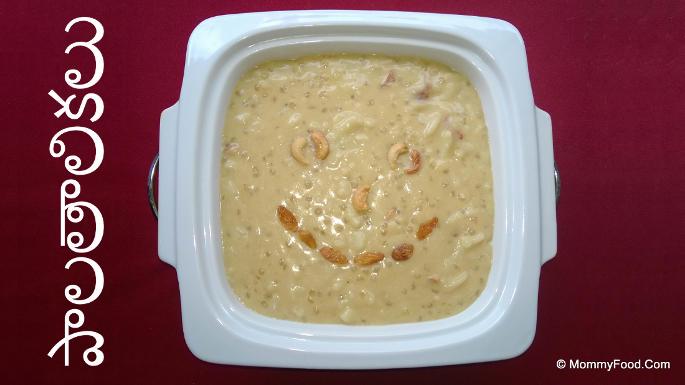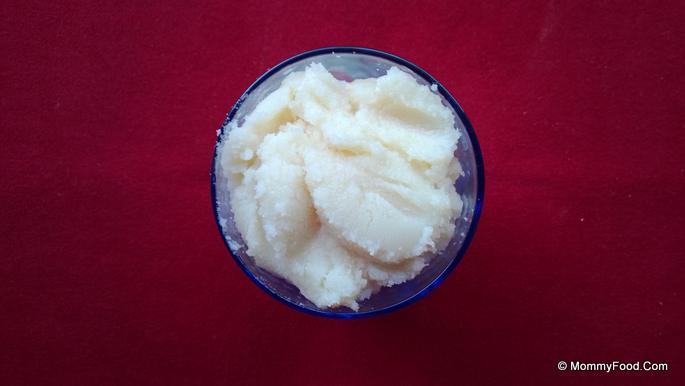Palathalikalu
Recipe prepared by Smt Mani Kumari
*****
Article written by Lakshmi Aparna

Introduction
Palathalikalu is a beloved traditional sweet dish, especially in Andhra Pradesh, prepared for festivals like Vinayaka Chavithi, Sankranti, and other auspicious occasions. The dish consists of delicate rice flour noodles, cooked in sweetened milk and flavored with jaggery, cardamom, and dry fruits like cashews and raisins. Each step in making Palathalikalu is done with care to ensure the dish has the perfect balance of sweetness and creaminess. This dessert holds a special place in the hearts of Telugu families and is commonly made as a Naivedyam (offering) to Lord Ganesha during Vinayaka Chavithi. Let's walk through the step-by-step process to create this festive treat, including tips to make the perfect Palathalikalu with the right texture and flavor.
Preparation Time: 15 minutes
Cooking Time: 15 minutes
Serves: 4
1 glass or Cup measuring: 250ml
Quick Navigation:
- Ingredients
- Procedure
- Step 1 : Soak the Sago
- Step 2: Prepare Jaggery Syrup
- Step 3: Make Rice Flour Mixture
- Step 4: Combine Rice Flour Mixture with Jaggery Syrup
- Step 5: Prepare the Dough
- Step 6: Boil the Milk
- Step 7: Add Sago to the Milk
- Step 8: Shape the Thalikalu
- Step 9: Allow to Cook Without Stirring
- Step 10: Add the Jaggery Syrup
- Step 11: Fry Cashews and Raisins
- Step 12: Serve
Ingredients
The ingredients for Palathalikalu are simple but carefully chosen to create a rich, flavorful dish. This traditional recipe uses rice flour as the base for making the thalikalu (noodles), which are combined with milk, jaggery, and dry fruits to bring out a delightful texture and sweetness. Here is what you?ll need:
Milk (Palu): 1 litre
Milk is the foundation of the dish, giving it a creamy texture. You can use whole milk for a richer taste, but if you prefer a lighter version, toned milk can also be used.
Jaggery (Bellam): 250 grams
Jaggery adds natural sweetness and gives the dish a deep, caramelized flavor that is unique to many South Indian desserts.
Sugar (Panchadara): 50 grams
In addition to jaggery, a small amount of sugar is used to balance the sweetness and enhance the overall flavor of the dish.
Rice Flour (Biyyam Pindi): 4 glasses (250 ml glasses)
Rice flour is used to make the dough for thalikalu. It?s important to ensure the rice flour is of high quality and finely ground to achieve a smooth dough.
Cashews (Jeedipappu): 50 grams
Cashews provide a crunchy texture and add a richness to the dish when fried in ghee and sprinkled over the finished dessert.
Raisins (Kismis): 50 grams
Raisins, when lightly fried, add a burst of sweetness to each bite of Palathalikalu.
Cardamom (Elaichi/Yalukalu): 5
Cardamom is the key spice in this dish, imparting a warm, fragrant aroma that complements the sweetness of the jaggery and sugar.
Ghee (Neyyi): 2 tsp
Ghee is used for frying the cashews and raisins, adding richness and depth to the final dish.
Sago (Saggubiyyam): 50 grams
Sago pearls give a chewy texture to the dish and blend well with the soft thalikalu.
Palathalikalu Maker: To shape the dough into thalikalu (rice flour noodles)
Procedure
The process of making Palathalikalu is a labor of love, involving careful steps to get the right consistency for both the rice flour noodles and the milk mixture. Each part of the process contributes to the dish?s delightful taste and texture.
Step 1 : Soak the Sago
Soak 50 grams of sago (saggubiyyam) in water for at least 1 hour. This will help soften the sago and allow it to cook faster in the milk later. Proper soaking ensures that the sago pearls turn soft and translucent when added to the boiling milk.
Step 2: Prepare Jaggery Syrup
In a small pan, add 1 tsp of mashed jaggery with 1 cup of water and boil it until the jaggery dissolves completely. This syrup will be mixed into the rice flour to help form the dough. The jaggery syrup not only adds sweetness but also gives the dough a rich caramel color.
Step 3: Make Rice Flour Mixture
In a bowl, mix 2 tsp of rice flour with a little water to make a thin slurry (palchaga kalupukovali). This mixture will be added to the jaggery syrup to thicken it and form a smooth, thick dough.
Step 4: Combine Rice Flour Mixture with Jaggery Syrup
Slowly pour the rice flour slurry into the boiling jaggery syrup while stirring continuously. This prevents lumps from forming. Cook this mixture on a low flame for about 5 minutes, until bubbles start appearing. Stirring ensures the mixture thickens uniformly.
Step 5: Prepare the Dough
Add the jaggery mixture to 4 glasses of rice flour and knead it into a smooth dough. Ensure there are no lumps in the dough, and it should be soft but firm enough to pass through the Palathalikalu maker.
Step 6: Boil the Milk
In a large pot, add 1 litre of milk and 1/2 litre of water (for whole milk) and bring it to a boil. The milk should be well-boiled to ensure the richness of the dish. If using toned milk, reduce the amount of water.
Step 7: Add Sago to the Milk
Once the milk begins to boil, add the soaked sago. Allow the sago to cook until it turns translucent and soft. This step is crucial because undercooked sago can remain chewy and spoil the texture of the dessert.
Step 8: Shape the Thalikalu
Now, insert the prepared dough into the Palathalikalu maker and slowly press the dough into the boiling milk, creating spirals of rice flour noodles. Do this over a medium flame, ensuring the dough is cooked well without breaking.
Step 9: Allow to Cook Without Stirring
Once all the dough is added, let it cook without stirring for about 5 minutes. Stirring can break the thalikalu, so it's best to let them cook gently. This step is key for maintaining the shape of the noodles.
Step 10: Add the Jaggery Syrup
After the thalikalu are cooked, add the cooled jaggery syrup to the milk mixture. Stir gently to combine. Do not add the syrup while it?s too hot, as it could cause the thalikalu to break.
Step 11: Fry Cashews and Raisins
In a small pan, heat 2 tsp of ghee and fry the cashews and raisins until golden brown. Add them to the Palathalikalu along with cardamom powder for a rich aroma and garnish.
Step 12: Serve
Traditional and delicious Palathalikalu is now ready to serve. This creamy, sweet, and textured dessert is perfect for any special occasion.
*** Rice Flour Preparation Tip: For best results, soak the rice (biyyam) for 24 hours, changing the water every 6 hours. Strain and grind into a smooth powder. Let the flour air-dry for 4-5 hours before use.
Like our recipes? You want us to do more?
Keep us running! Buy from our affiliate store:
US | Amazon Best Sellers & Deals
India | Amazon Best Sellers & Deals





Comments powered by CComment